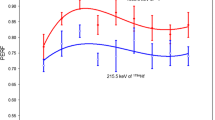Summary
Potassium is an extremely important major element to the human body. Potassium is made up of three isotopes with abundances of 39K at 93.1%, 40K at 0.0118% and 41K at 6.88%. It is also very well known that 40K with its 1.3 . 109 years half-life is a major naturally occurring isotope in the body and food. The usual way to determine total 40K is to measure the single 1460.8 keV photon from beta-decay. However, this procedure requires a significant amount of sample and typical counting periods of at least a day in well-shielded germanium counting system. Another approach is to determine total potassium via neutron activation analysis using the well known 41K(n,g)42K (T1/2 = 12.8 h) reaction and then evaluate 40K using the usual activity equation A = lN. In our laboratory we have effectively used epithermal neutron activation analysis and Compton suppression to determine potassium in air filters and other geological material. Upwards to 10-15 samples can be analyzed in one day using only gram quantities of material. In such way one can increase the output of determining 40K by at least one order of magnitude. Results of a detailed investigation optimization of the methodology, quality control and detection limits will be presented for reference material and various food samples.
Similar content being viewed by others
Author information
Authors and Affiliations
Rights and permissions
About this article
Cite this article
Sanchez, M., Landsberger, S. & Braisted, J. Evaluation of 40K in food by determining total potassium using neutron activation analysis. J Radioanal Nucl Chem 269, 487–490 (2006). https://doi.org/10.1007/s10967-006-0412-2
Issue Date:
DOI: https://doi.org/10.1007/s10967-006-0412-2



